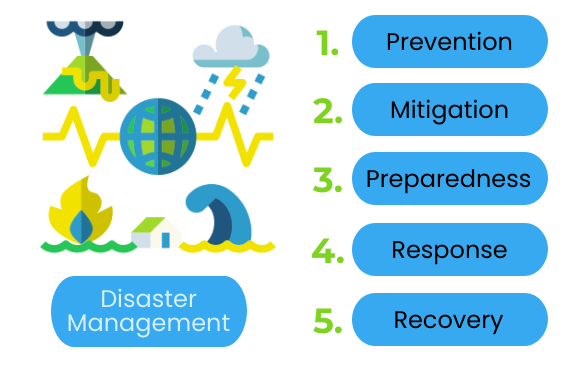Without a doubt, a natural disaster essay is a tough paper to write.
To begin with, when people encounter a disaster risk, it’s a tragedy. Emergency situations can affect hundreds, thousands, and millions of people. These are the crises and events that change people’s lives drastically. So, disaster and emergency management essay topics aren’t that fun to discuss.
Moreover, an essay on disaster management requires thorough research. Mentioning how people handle natural hazards and recovery from such tragedies is essential for the paper. But you can approach the discussion from different sides.
In this article, our experts will help you with the following:
- How to nail disaster management essay writing.
- What to write your paper about.
- Types of disaster management and their importance.
And good luck!
👨💼 Essay on Disaster Management: What Is It About?
What is natural disaster management, anyway? What is the role of adults and youth in it?
Disaster management is the management and organization of responsibilities and resources. Its goal is to deal with the humanitarian aspects of an emergency. Put simply, how to help victims of natural disasters.
There are five stages of the disaster management process:

Let’s see what each of these stages entails.
Prevention
The name of this stage explains its purpose. Its primary focus is on preventing hazards and potential natural disasters.
Measures are usually taken on different scales, including international and domestic levels. They’re designed to provide reliable protection from possible disasters.
Of course, it isn’t possible to stop all disasters. But there’s always a chance to minimize the risks of injuries and loss of life. All thanks to environmental planning, evacuation plans, and the introduction of specific design standards.
Mitigation
Mitigation measures are those that are taken before a disaster or emergency happens. It aims to reduce or eliminate the risks and impact a hazard can have on people and the environment.
Mitigation measures come in different forms depending on the hazard itself.
Here are some examples of possible actions:
- Structural changes to buildings
- Securing items inside buildings
- Installation of generators
- Construction of shelters
- Large-scale mitigation measures on the national level
Preparedness
The focus of this stage is to prepare supplies and equipment. It also involves developing usage procedures when a disaster happens.
The primary goal is to reduce the level of people’s vulnerability to a disaster. Also, to mitigate a disaster’s impact. And to be able to have a more effective response in case of an emergency.
Organizations like the Federal Emergency Management Agency (FEMA) even develop a disaster management plan. They also make disaster supply kit lists. Other agencies and organizations use them to teach people how to help each other. Or they modify those plans to increase their effectiveness. Those can be found on the web in the form of downloadable PDF files or printed handouts.
Response
The response stage aims at fulfilling the humanitarian needs of the population affected by a disaster. Depending on the consequences, anyone can provide such assistance, including individuals, social workers, organizations, national and international agencies.
The most important part of the proper response is the effective coordination of assistance, especially if there’s a misbalance in the amounts of demand and the available answers.
In the case of massive and overwhelming disasters, donations play a crucial role in the response process. They range from all kinds of gifts to money (which is the most efficient type of assistance).
Recovery
The question is: can communities recover after the disaster happens?
The recovery stage begins after the threat to human life is gone. The goal here is to bring the affected area back to normal condition as quickly and efficiently as possible.
This stage usually involves numerous processes—reconstructing buildings, refilling food availability, and preparing the equipment.
✍️ Disasters to Write About
As we’ve mentioned earlier, disasters are divided into two categories—natural and man-made.
🌪️ Natural Disasters
Natural disasters are phenomena or processes that occur due to a force of nature and hurt the environment and people. They can cause injuries, property damage, environmental damage, and loss of life or other health impacts.
There are two types of natural disasters—geological hazards (involving geological processes) and meteorological hazards (or climate hazards).
Geological Hazards
A geological hazard is an extreme natural event in Earth’s crust that represents a threat to life and property. Now, let’s take a closer look at them.
Meteorological Hazards
Meteorological hazards are calamities caused by extreme weather factors, such as temperature, humidity, and wind speed. So, let’s talk in more detail about these.
⚡ Man-Made Disasters
Man-made disasters (also known as anthropogenic) are events caused by the action or inaction of humans. These disasters also affect the environment, humans, other organisms, and ecosystems.
Let’s now move to describe disasters themselves to give you ideas for your future essay.
Societal Hazards
Most societal hazards can be prevented by taking proper measures and actions. These hazards usually appear due to anti-social and criminal behavior. It all can be reported if spotted at the right time.
Hazards Related to Dangerous Materials
Dangerous materials released from man-made or natural hazards threaten human health by increasing the possibility of human exposure to hazardous materials. So, now, let’s take a look at them.
Transportation Hazards
Transportation hazards include disastrous events that can happen anywhere. On the road, in aviation, on railways, in sea travel, and even in space. Several reasons can cause a crash, from mechanism malfunctions to trivial inattention or carelessness. Such catastrophes not only endanger the people involved in them. They also harm the environment, for example, when freight vehicles are involved.
Environmental Hazards
A man-made disaster is classified as environmental if it affects ecosystems and biomes. Such disasters include air pollution, uncontrollable deforestation, oil spills, and water pollution.
🌎 Disaster Management Topics for Essays
- The role of the government oeganizations in mitigation of natural disasters.
- Discuss how to address the needs and demands of vulnerable population in disaster management.
- Explain why earthquakes are among the most dangerous natural disasters.
- Natural disasters and the strategies of disaster management in Katmandu.
- Natural disasters and vulnerable health populations.
- Describe the ways to improve disaster response.
- Discuss the cases of post-disaster fraud and how to prevent them.
- Analyze the level of natural disaster preparedness in Texas.
- Compare international and South Africa’s disaster management.
- What disaster mitigation strategies can reduce the consequences of flash floods.
- Examine how natural disasters influence various systems.
- Describe the ways media responds to natural disasters.
- The vital role of SNS in a case of a disaster.
- Analyze ethical and legal issues that arise in case of a natural disaster.
- Explain why hurricane Katrina is considered one of the worst national disasters in the USA.
- Describe 2 different global disasters and explain their causes.
- Discuss the importance of emergency planner in effective disaster preparedness.
- Issues that may arise during rebuilding and recovery after natural disaster.
- The main aspects of safety and disaster training for healthcare workers.
- Analyze winter snow disaster in Philadelphia and its impact on the community.
- Describe the effect of natural disasters on the supply chain.
- Examine the reasons and consequences of the Budalangi flood.
- Explain why the 1900 Galveston hurricane is regarded as disaster management failure.
- Explain why the problem of wildfire in California is getting out of control.
- Discuss the response to the Indian Ocean earthquake and tsunami.
- Compare and analyze the earthquakes in California and Armenia.
- What were the causes and consequences of Haiti earthquake.
- The management of evacuations from Gulf Coast hurricanes.
- Describe what the emergency response to a volcano eruption should be.
- Why was the blizzard of 1888 so deadly?
- Is it possible to avoid catastrophic drought?
- Analyze how media depicts droughts in Africa.
- Discuss economic and environmental consequences of earthquakes.
- The importance of proper training for an effective disaster management.
- Explain the meaning of “New Normal” concept after disaster.
- What steps should government take for better protection from wildfire?
- Basic aspects of disaster management in big cities.
- Analyze the issues and lessons of hurricane Katrina.
- Compare the preparedness and response strategies to Haiti and Japan’s earthquake.
- Describe tsunami causes and countermeasures.
❓ Essay-Type Questions on Disaster Management
- What is the role of community-based organizations in managing regional disasters?
- What are the major global trends in disaster management?
- How can we help children cope and adjust after a disaster?
- What are the pros and cons of AI technology in catastrophe management?
- What role does early warning play in disaster management?
- Why is family unification one of the critical issues in disaster planning?
- What are the social and economic consequences of natural disasters?
- What characterizes disaster management in developing countries?
- How does natural ecosystem restoration contribute to disaster risk reduction?
- What are the key components of a comprehensive disaster management plan?
- What are the problems associated with organizing international disaster relief efforts?
- Why is psychological support a critical component of post-disaster management?
- What key elements should hospital evacuation plans consider?
- What are the peculiarities of disaster management plans for people with disabilities?
- How can climate change adaptation strategies be used in disaster management?
- What are the benefits of the disaster management cycle?
- What can a regular person do to help their community recover from a disaster?
- How can cyberattacks on critical infrastructure exacerbate disaster scenarios?
- What is the importance of international cooperation in disaster management?
- How can disaster management motivate individuals to be active in their own safety?
- What are the ethical considerations in providing humanitarian aid in a disaster zone?
- How can you help others who might be more vulnerable during disasters?
- What common mistakes do people make when preparing for a disaster?
- Why is it important to have a disaster plan for your family or community?
- What are the specific risks of highly populated urban areas during natural disasters?
- How can psychological support programs be effective in post-disaster recovery?
- What is the role of land-use planning in mitigating disaster risks?
- How can collaboration between hospitals improve response to disaster?
- Why is mitigation one of the most critical phases of disaster management?
- How can physiotherapists effectively contribute in disaster situations?
- What are the key aspects of disaster preparedness?
- Why is it critical to invest in technologies for improving disaster response strategies?
- Why do different types of disasters require different management strategies?
- What are the ethical considerations in disaster mitigation and recovery?
- Why is effective communication essential during and after a disaster event?
- What technologies and methods are used to warn people about impending disasters?
- What role can education programs play in preventing anthropogenic catastrophes?
- How can urban planning help to minimize the impact of disasters on cities?
- What are the most effective ways to stay safe during a flood?
- What is the connection between cultural diversity and disaster preparedness?
🔥 Disaster Title Ideas for Essays
- Explore the role of disaster preparedness in reducing the effects of disasters.
- Flood prevention measures and their importance in vulnerable regions.
- The efficiency of scientific methods and technologies in predicting volcanic activity.
- Write about the function of social workers in China’s disaster management programs.
- How past disaster experiences can help prevent future catastrophes.
- The effectiveness of reforestation programs in restoring ecosystems.
- Housing programs and their role in post-disaster recovery.
- Compare the US and UK disaster management systems.
- Earthquake-resistant materials and their role in mitigating damage during earthquakes.
- Evaluate the use of coastal infrastructure in protecting from wave surges.
- The potential of green infrastructure in preventing floods.
- Cultural heritage preservation and its role in disaster management.
- The use of the Incident Command System in effective disaster management.
- Study the factors leading to building collapses and measures to prevent such disasters.
- The role of volunteers in the disaster management process.
- Biodegradable disaster cleanup technology and its pitfalls.
- Ethics in the practices and policies of disaster management.
- Review the challenges for preserving cultural heritage in coastal areas affected by wave surges.
- Energy-efficient buildings and their role in temperature regulation.
- Assess the importance of community education in minimizing the impact of volcanic eruptions.
- The influence of economic disparities on post-disaster recovery.
- Insurance and its role in mitigating the financial impacts of disaster.
- The importance of vaccination programs in preventing pandemics.
- Man-made disasters and their prevention strategies.
- Review the key methods of protecting vulnerable populations during heatwaves.
- The role of NGOs and international aid in volcano recovery.
- Potential challenges of global disaster management systems.
- Study the key pitfalls of tourism disaster management.
- Evacuation plans and their use in minimizing the risks of wildfires.
- Look into the social-cultural aspects influencing community resilience to disaster.
- Circular economy principles and their application in waste management.
- Evaluate the importance of international collaboration in preventing biosecurity risks.
- Safety practices and regulations to prevent dam failures.
- The use of risk management protocols in chemical plant explosion prevention.
- Sustainable agriculture practices and their use in reducing soil erosion.
- Evaluate the effectiveness of emergency response plans during extreme heat events.
- Post-tsunami mental health support and its importance.
- The strategies for minimizing economic impact in regions with active volcanoes.
- Study how social networks can assist in coordination during disaster events.
- Cyclone disaster management system and its main issues.
- Review the core components of a disaster response and their peculiarities.
- The efficiency of investing in resilience to reduce the impact of future disasters.
📑 Essay on Disaster Management: How to Write
If you’re writing an essay on such a serious topic, a how-to guide will be of great help. Here, we explore the ideas and issues to explore in your paper and the way to organize it.
Check what information your natural disasters essay can include.
Start with the Basics
We skipped it in this post, but you shouldn’t do this in your paper.
When writing a natural disasters essay of 500 words, or 1000 words, it’s essential to start with some general facts:
- A natural disaster definition would be a good beginning. Tell about various types, too.
- You can also provide information about a national disaster of your choice.
- Talk about countries that suffer from it more frequently than others, like India, Japan, etc.
- You can also write a quick rundown of the latest natural disasters.
Don’t forget to make this part meaningful, leading to your thesis statement, where you state your position.
Go into More In-Depth Details
In the main body, provide specific details about the catastrophe you’ve decided to describe:
- the locations where it can happen,
- causes of natural disasters,
- effects this particular disaster can have (both on the environment and in people’s lives),
- and more.
Elaborating on each issue, offer evidence. For example, the disaster’s effect on transportation, infrastructure, economy, and so on can be supported by worldwide statistics data. A previously made outline might be a great help here.
Another thing you can do:
You can compare the disaster in question with other ones of the same type. Talk about the damages caused by them and how people dealt with the aftermath. Provide a couple of examples to prove your point.
Be sure to provide as many details as possible. As a result, your essay is maximally useful.
Talk About Disaster Management
Now, you can pass on the details of handling the situation. To be more specific, you’re going to tell your readers what to do in case of a catastrophe.
In this part of your essay on disaster management, you will have to talk about its phases. They are:
- Prevention
- Mitigation
- Preparedness
- Response
- Recovery
We’ll talk more about disaster management later on in the article.
Make Your Disaster Essay Even More Helpful
Do you want to make your disaster management essay more informative and impressive? Then tell about various organizations that deal with managing disasters. These resources can also help natural disaster victims or those who want to be aware of all the necessary information if something terrible happens.
Say a few words about the following organizations:
- International Association of Emergency Managers
- Red Cross
- World Bank
- PreventionWeb
- United Nations Office for Disaster Risk Reduction
- FEMA Recovery Resources
- Disaster Resource Guide
- Disaster Assistance
- American Red Cross
- Habitat for Humanity
- The Salvation Army
- World Confederation for Physical Therapy disaster management resources
These resources provide information about the prevention of natural disasters and what types of assistance are available. How to find missing friends or family members? What are the ways of recovering after disaster strikes? There are also community resources that can help with recovery.
End on a High Note
You don’t want to frustrate your reader, leaving them with a bitter impression. No matter how long your natural disaster essay is – 200 words, 300 words, or a thousand. It’s crucial to deliver a positive message.
Here’s what you can do;
- Talk about the consequences. Tell about the lessons that catastrophic events you’ve described teach us, as human beings. Spreading awareness about the consequences is essential, especially if we talk about man-made disasters. You might mention the role of the media in spreading awareness about environmental disasters.
- Talk about dealing with disasters. It might be a natural disaster, such as a tsunami, or human-made, like the Chernobyl disaster. Your essay should include info about how people dealt with them. The experience individuals get from dealing with disasters is priceless.
- Mention the value of human life. Encountering natural disasters reminds people of how fragile their lives are. It shows the importance of cherishing the life given.
In the end, you’ll have to summarize your essay and restate your thesis. While you try not to leave a negative message, don’t present any new thoughts or concepts. Draw a clear conclusion from the info mentioned in the body.
🖊️ Natural Disasters Essay 300 Words
Check out our essay example on natural disasters below to learn more about structuring your paper. And if you want more examples, try our free Chat GPT Essay Writer to generate a custom-made disaster essay sample tailored to your requirements.
Example:
Hurricane Katrina: Disaster Management Strategies
Introduction
In August 2005, Hurricane Katrina hit the southeastern United States. It became one of the most devastating natural disasters in the history of the country, resulting in 1,833 fatalities and $108 billion in damage. The experience learned from Hurricane Katrina, including both successes and failures, provides important insights for improving disaster management strategies.
Main body
Among the effective measures implemented were immediate rescue and social media coordination. Despite initial logistical challenges, the quick deployment of rescue teams, including the Coast Guard and volunteer organizations, saved countless lives. At the same time, social media platforms such as Twitter and Facebook have become effective tools for spreading information as well as reuniting families and organizing volunteers. The emergence of crowdfunding websites such as GoFundMe also helped affected communities and families by providing them with financial support.
Despite all efforts, Katrina also revealed shortcomings in disaster response and preparedness. Levee failures, in particular, which are a result of inadequate infrastructure, made the flooding more destructive. Besides, the government faced long-term recovery challenges due to bureaucratic obstacles. There were also challenges caused by inequitable resource distribution and limited access to mental health services. All these factors made reconstruction more difficult and isolated some communities, which highlighted the need for more inclusive and equitable strategies for recovery.
Conclusion
The struggle with the consequences of Hurricane Katrina became a lesson for the United States and the whole world. Recognizing both successful and unsuccessful strategies allows us to draw important conclusions for the next decades. In the event of future disasters, it will be crucial to prioritize community-based preparedness, efficient communication, a robust infrastructure, and equitable resource distribution to boost resilience and save more lives.
Want to see a fully-formatted natural disasters essay sample? Feel free to download it in PDF format below:
Example:
The inevitability of natural disasters and the frequent occurrence of human-made disasters necessitate well-planned effective emergency management approaches that employ functional and cost-efficient methods. Since disasters entail multiple financial losses, property damage, and most importantly, impose a significant threat to human health and life, medical preparedness constitutes a pivotal part of the disaster management process.
Hopefully, you’ve found this guide on natural disaster essay writing useful.
If you have any thoughts on writing disaster essays—make sure to leave a comment about it below. You can also leave a comment if you want to share more disaster resources. Have any questions, suggestions, or even a story to tell? Leave a comment!
This might be interesting for you:
- Efficient Essays on Environment vs. Development: Useful Tips
- Responsibility Essay: How to Write, Topic Ideas and Examples
- How to Write a Narrative Essay: Easy Guide and Useful Tips
🔗 Resources
- What is a Disaster?
- Natural Disaster
- Has volcanic activity been increasing?
- What is disaster management?
- What is a Disaster Management Specialist?
- Disaster Planning
- Types of Disasters
- Effects of Disasters: Risk and Resilience Factors
- Proper Emergency Kit Essential to Hurricane Preparedness
- Preventing Natural Hazards From Becoming Societal Disasters
- Natural hazards and disaster risk reduction
- Disaster Preparation and Recovery
- Emergency Response Resources










![Essay for Primary School: Simple Guide for Kids [with Samples]](https://custom-writing.org/blog/wp-content/uploads/2020/12/pupils-raising-hand-classroom-284x153.jpg)

It’s really superb!
Wow. It is very helpful. Thanks.
What is the most effective process of prevention disasters?
It’s quite a complex process, and there’s definitely more than one choice.
Thank you a lot. I found this post very helpful in writing my essay on disaster management. Best regards, Michael
Thanks for the excellent guide to writing an essay on disaster management. Very helpful points to include in a disaster management paper! I wish you good luck!